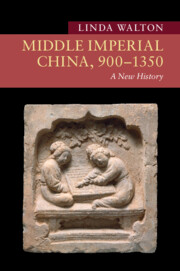Book contents
- Middle Imperial China, 900–1350
- New Approaches to Asian History
- Middle Imperial China, 900–1350
- Copyright page
- Dedication
- Contents
- Figures
- Maps
- Acknowledgments
- Introduction
- 1 The Turbulent Tenth Century
- 2 Song in a Multipolar World
- 3 Schooling, State, and Society in Song and Jin
- 4 An Economic Revolution?
- 5 Cities and Urban Life
- 6 Religious Transformations
- 7 Ways of Knowing
- 8 The Arts of Culture
- 9 Gendered and Generational Lives
- 10 Mapping the Built and Natural Environment
- 11 Sustaining Life and Healing Bodies
- 12 The Mongol Yuan Dynasty in China
- 13 Yuan China in the Mongol Eurasian Empire
- Bibliography
- Index
- New Approaches to Asian History
13 - Yuan China in the Mongol Eurasian Empire
Published online by Cambridge University Press: 20 July 2023
- Middle Imperial China, 900–1350
- New Approaches to Asian History
- Middle Imperial China, 900–1350
- Copyright page
- Dedication
- Contents
- Figures
- Maps
- Acknowledgments
- Introduction
- 1 The Turbulent Tenth Century
- 2 Song in a Multipolar World
- 3 Schooling, State, and Society in Song and Jin
- 4 An Economic Revolution?
- 5 Cities and Urban Life
- 6 Religious Transformations
- 7 Ways of Knowing
- 8 The Arts of Culture
- 9 Gendered and Generational Lives
- 10 Mapping the Built and Natural Environment
- 11 Sustaining Life and Healing Bodies
- 12 The Mongol Yuan Dynasty in China
- 13 Yuan China in the Mongol Eurasian Empire
- Bibliography
- Index
- New Approaches to Asian History
Summary
Under Mongol rule and the Pax Mongolica, Song China became part of the much wider world of the Mongol Empire. Although it was split into four khanates in 1260, Qubilai consolidated control over Goryeo and Dali and, where conquest failed (as in Dai Viet, Kamakura Japan, and Java), pursued diplomatic and commercial relationships, especially on the Indian subcontinent. Mongol rule integrated China into an overland global economy parallel to the maritime one in the South Seas and the Indian Ocean. Ceramic production under the Mongols played a major role in maritime trade, while the blue-and-white porcelain seen in the Yuan exemplifies contact across Eurasia. Textile production likewise stimulated commerce and contact across Eurasia. Silk production long antedated this era, but patterns and designs produced under the Mongols exhibit Central Asian influences, as silk from China made its way westward as far as the Mediterranean and beyond. The Mongol era dietary, A Soup for the Qan, illustrates Eurasian interconnections visible through the lenses of food and medicine. Along with steppe shamanism, the Mongols favored Tibetan Buddhism, but they also implemented policies of official toleration toward recognized faiths (including Eastern Syriac and Roman Catholic Christianity), creating one of the most ecumenical societies in world history.
Keywords
- Type
- Chapter
- Information
- Middle Imperial China, 900–1350A New History, pp. 324 - 356Publisher: Cambridge University PressPrint publication year: 2023

